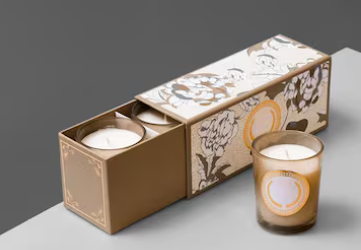Candles have long been symbols of warmth, relaxation, and celebration. Whether used for home décor, gifting, or religious purposes, candles bring a comforting glow into our lives. But have you ever noticed what truly makes a candle brand stand out on the shelves or in online stores? It’s not just the scent or shape—it’s the packaging. Candle boxes play a crucial role in both protecting the product and defining the brand’s identity.
This guide explores everything about candle boxes—from materials and design considerations to sustainability trends and branding strategies.
Understanding the Purpose of Candle Boxes
At first glance, candle boxes might seem like simple containers. However, their role extends far beyond that. They ensure that candles remain safe from dust, moisture, and breakage while in transit or storage. Moreover, well-designed boxes enhance the perceived value of the product, influencing buying decisions.
For candle manufacturers and small businesses alike, packaging is the first handshake with the customer. It tells the story of what the brand stands for—elegance, sustainability, creativity, or luxury.
Key Features That Make Candle Boxes Effective
Candle boxes are designed with multiple goals in mind. The best packaging is a mix of protection, aesthetics, and practicality. Below are the features that make them effective:
1. Sturdy Construction
Candles, especially glass jar candles, are fragile. Boxes must offer adequate protection against impacts during shipping. High-quality cardboard, kraft paper, or corrugated board ensures durability without adding excessive weight.
2. Custom Fit and Inserts
To prevent movement inside the box, inserts or dividers are used. These keep candles snugly in place and prevent damage to labels or containers.
3. Elegant Visual Appeal
From matte finishes and gold foiling to embossing and die-cut windows, packaging design plays a significant role in customer attraction. The more visually pleasing the box, the more premium the candle appears.
4. Eco-Friendly Design
Today’s consumers value sustainability. Brands are shifting to biodegradable materials and soy-based inks for eco-conscious packaging solutions that appeal to environmentally aware shoppers.
Types of Candle Boxes for Every Need
The type of candle box depends on the product’s shape, size, and target audience. Below are the most common types used in the market today:
1. Rigid Candle Boxes
Luxury candle brands often use rigid boxes. These boxes feel premium and can include magnetic closures, ribbon pulls, or custom inserts. They’re ideal for gifting and create an unforgettable unboxing experience.
2. Kraft Candle Boxes
Made from natural brown kraft paper, these boxes are strong and eco-friendly. Their earthy look suits organic or handmade candle brands that emphasize sustainability and simplicity.
3. Sleeve and Tray Boxes
These feature an inner tray that slides into a sleeve. They are practical, stylish, and give a neat presentation. Sleeve boxes are often used for scented candles and gift sets.
4. Window Boxes
A small transparent window on the box allows customers to see the candle’s color or texture without opening it. This enhances product visibility and customer trust.
5. Folding Carton Boxes
Lightweight and cost-effective, folding cartons are perfect for mass production. They can be easily printed with custom artwork and logos, making them ideal for branding.
Material Choices for Candle Boxes
The quality of materials defines how well candle boxes perform and how they are perceived by customers. Some popular material options include:
- Cardboard: Lightweight yet durable, suitable for standard candles.
- Corrugated Board: Excellent for shipping or heavy candle jars.
- Rigid Board: Used for high-end, luxury candle collections.
- Recycled Paper: Perfect for brands focusing on eco-friendly packaging.
The goal is to balance cost-effectiveness with protection and visual appeal. For brands, choosing the right material aligns with their market position—affordable, mid-range, or premium.
Design Elements That Influence Buying Decisions
A well-designed candle box goes beyond protection—it creates emotional value. Design is what makes a buyer pick one candle over another. Here are key design elements to consider:
Color Psychology
Colors evoke emotions. Warm tones like gold and beige suggest comfort and luxury, while pastels convey calmness and relaxation. Bold black or white boxes, on the other hand, communicate elegance and modernity.
Typography and Logo Placement
Clean, readable fonts enhance brand recognition. The logo should be visible but not overpowering. A minimalist design often looks more refined than a cluttered one.
Finishing Touches
Special finishes such as embossing, spot UV, or metallic foiling make packaging stand out on retail shelves. They create texture and depth, giving customers a tactile experience that builds brand trust.
Branding Through Candle Boxes
Candle packaging is more than a container—it’s a communication tool. It reflects the brand’s personality and values. Custom candle boxes allow businesses to differentiate themselves in a competitive market.
For example, a luxury candle brand might choose matte black rigid boxes with gold foil lettering, while an organic candle business may use kraft boxes with natural twine and recycled labels. The packaging instantly conveys the brand’s positioning and appeals to its target audience.
This is where candle packaging boxes make a difference—they combine branding, design, and protection into one unified experience that enhances perceived product value.
The Role of Sustainability in Candle Packaging
Sustainability is no longer an optional feature—it’s a customer expectation. Eco-conscious packaging helps brands gain credibility and customer loyalty. Some of the most popular sustainable choices include:
- Using biodegradable cardboard or recycled kraft paper.
- Printing with soy-based or water-based inks instead of petroleum-based ones.
- Eliminating plastic components such as window films.
- Encouraging recyclable or reusable packaging.
Brands that highlight their environmental responsibility often see increased trust and positive brand perception.
How Candle Boxes Add Value to the Product
Candle boxes contribute to product value in several ways:
- First Impression: Beautiful packaging catches the eye and draws customers in.
- Unboxing Experience: The moment of opening the box can turn a purchase into an experience worth sharing on social media.
- Gift Appeal: Stylish boxes make candles more suitable as gifts.
- Product Information: Labels and boxes communicate scent type, burn time, and ingredients—details that influence purchasing decisions.
- Shelf Presence: Attractive packaging helps candles stand out among competitors in retail stores.
Trends in Modern Candle Box Design
As the candle industry grows, packaging trends continue to evolve. Here are a few that are shaping the market today:
- Minimalist Designs: Clean lines and soft tones create a high-end aesthetic.
- Vintage-Inspired Boxes: Retro typography and textures evoke nostalgia.
- Reusable Packaging: Some brands offer reusable candle boxes or containers that customers can repurpose.
- Custom Illustrations: Artistic designs and illustrations make boxes unique and memorable.
Conclusion: The Perfect Blend of Style and Purpose
Candle boxes are more than simple packaging—they are an integral part of the candle business strategy. They protect delicate products, communicate brand identity, and create memorable unboxing moments that turn buyers into loyal customers. Whether you run a small candle studio or a large brand, investing in creative and sustainable packaging will elevate your products and strengthen your market presence. Thoughtful design, premium materials, and eco-friendly practices together make candle boxes the silent ambassadors of your brand.








Leave a Reply